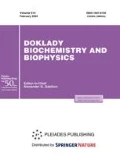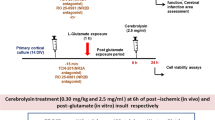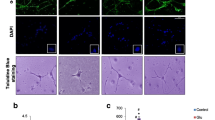Abstract
Glutamate (Glu) excitotoxicity, which accompanies brain ischemia or traumatic brain injury, is the leading mechanism of neuronal death. In the present work, we studied the effects of the peptides HFRWPGP (ACTH6–9PGP), KKRRPG, and PyrRP on the survival of cultured cortical neurons on the background of excitotoxic effect of Glu (100 µM). Biochemical (MTT/WST) and morphometric analyzes showed that, depending on the dose, ACTH6–9PGP and KKRRPGP protect neurons from the cells death, while PyrRP, conversely, enhances it. The neuroprotective effect of ACTH6–9PGP is accompanied by a slowdown in the development of delayed calcium dysregulation and synchronous mitochondrial depolarization. Among the studied peptides, only ACTH6–9PGP significantly increased the number of neurons that restored Ca2+ homeostasis after Glu was abolished. The influence of KKRRPGP was less pronounced, whereas PyrRP, on the contrary, reduced the number of neurons with low [Ca2+]i. Thus, this study revealed the high therapeutic significance of ACTH6–9PGP and allowed assessing the prospects for its possible clinical use.


Similar content being viewed by others
REFERENCES
Bezuglov, V.V., Akimov, M.G., Gretskaya, N.M., et al., Horizons Neurosci. Res., 2015, vol. 21, pp. 151–170. ISBN 978-1-63482-967-0
Storozhevykh, T.P., Tukhbatova, G.R., Senshova, Ya.E., et al., Bull. Exp. Biol. Med., 2007, vol. 143, no. 5, pp. 538–541. https://doi.org/10.1007/s10517-007-0192-x
Pinelis, V.G., Surin, A.M., Sorokina, E.G., et al., in “Neirobiologicheskie osnovy vozniknoveniya i vosstanovitel’nogo lecheniya perinatal’nogo porazheniya tsentral’noi nervnoi sistemy u detei” (The Neurobiological Bases of Occurrence and Restorative Treatment of Perinatal Lesions of the Central Nervous System in Children), Izd. Pediatr, 2016, pp. 9–76. ISBN 978-5-906332-79-0
Myasoedov, N.F., Vestn. Ross. Akad. Nauk, 2016, vol. 86, no. 6, p. 488. https://doi.org/10.7868/S0869587316060074
Levitskaya, N.G., Glazova, N.Yu., Sebentsova, E.A., et al., Ross. Fiziol. Zh. im. I.M. Sechenova, 2019, vol. 105, no. 6, pp. 761–770. https://doi.org/10.1134/S0869813919060049
Shevchenko, K.V., V’yunova, T.V., Nagaev, I.Yu., et al., Russ. J. Bioorg. Chem., 2013, vol. 39, no. 3, pp. 320–325. https://doi.org/10.1134/S1068162011040133
Surin, A.M., Krasil’nikova, I.A., Pinelis, V.G., et al., Patogenez, 2014, vol. 12, no. 4, pp. 40–46.
Khodorov, B., Progr. Biophys. Mol. Biol., 2004, vol. 86, pp. 279–351. https://doi.org/10.1016/j.pbiomolbio.2003.10.002
Nicholls, D.G., Biochem. Soc. Trans., 2009, no. 37, pp. 1385–1388. https://doi.org/10.1042/BST0371385
Brustovetsky, T., Li, V., and Brustovetsky, N., Cell Calcium, 2009, vol. 46, no. 1, pp. 18–29. https://doi.org/10.1016/j.ceca.2009.03.017
www.rndsystems.com/resources/protocols/protocol-culturing-rat-cortical-neurons
Hardingham, G.E. and Bading, H., Nat. Rev. Neurosci., 2010, vol. 10, no. 11, p. 682. https://doi.org/10.1038/nrn2911
Duchen, M.R., Pflüegers Arch.—Eur. J. Physiol, 2012, vol. 1, no. 464, pp. 111–121. https://doi.org/10.1007/s00424-012-1112-0
Funding
This work was supported by the Russian Foundation for Basic Research (project nos. 17-00-00105_COMFI and 17-00-00106_COMFI).
Author information
Authors and Affiliations
Corresponding author
Ethics declarations
Conflict of interest. The authors declare that they have no conflict of interest.
Statement on the welfare of animals. Animal experiments were performed in accordance with the regulations recommended by the European Science Foundation and the Order of the Ministry of Health of the Russian Federation “On Approval of the Rules of Good Laboratory Practice” no. 708n from August 23, 2010.
Additional information
Translated by M. Batrukova
Rights and permissions
About this article
Cite this article
Bakaeva, Z.V., Surin, A.M., Lizunova, N.V. et al. Neuroprotective Potential of Peptides HFRWPGP (ACTH6–9PGP), KKRRPGP, and PyrRP in Cultured Cortical Neurons at Glutamate Excitotoxicity. Dokl Biochem Biophys 491, 62–66 (2020). https://doi.org/10.1134/S1607672920020040
Received:
Revised:
Accepted:
Published:
Issue Date:
DOI: https://doi.org/10.1134/S1607672920020040




